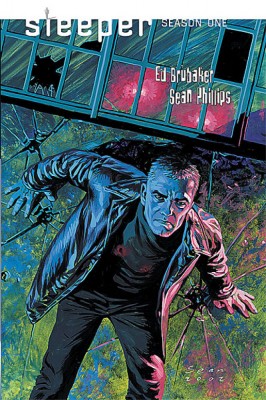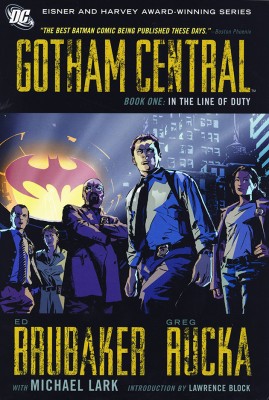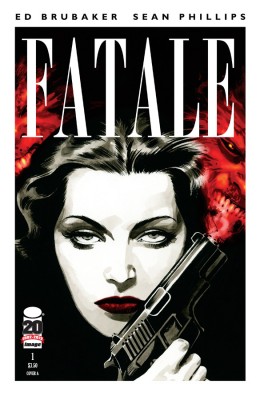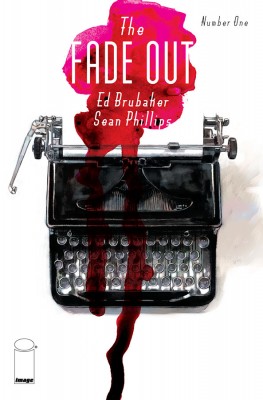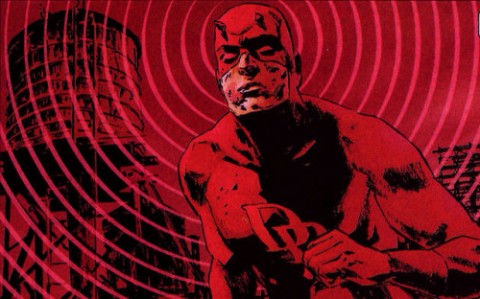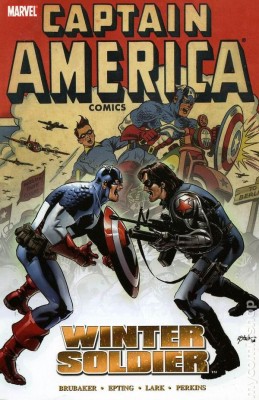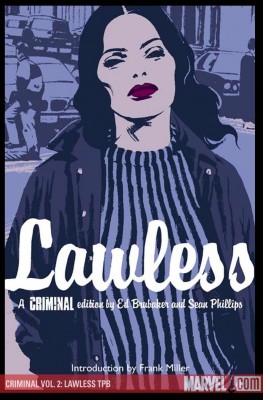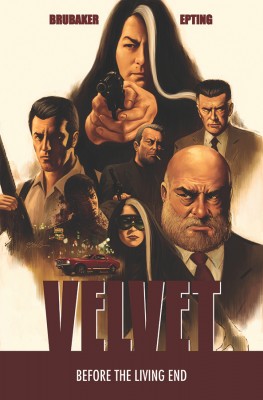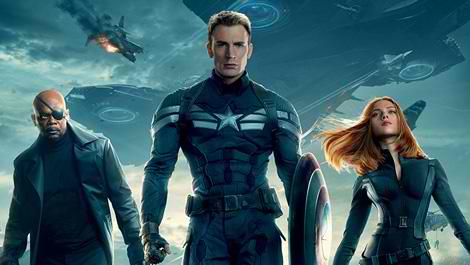Why is ED BRUBAKER Awesome ?
I know many comic aficionados and readers are already familiarized and read Stan Lee, Alan Moore, Neil Gaiman and Grant Morrison’s respective opuses. To more sophisticated types, the names Mark Waid, Kurt Busiek, Garth Ennis, Jason Aaron, Brian Vaughan, Chris Claremont, Walter Simonson, Frank Miller, Mark Millar, Denny O’Neil and Brian Michael Bendis grace the visual literatures and made distinctive marks of their own visions that later become synonymous with. And recently, more and more writers show their brand of specialization that caters to both discerning critics and even casual readers who just love the comic medium. Ed Brubaker stands out of this ever growing crowd of competent, consistent, and critically-acclaimed comic book scribes that we should read and enjoy.
Brubaker’s impressive line of visual literature should be taken seriously. His SLEEPER (DC Comics/Vertigo) presents readers who an anti-hero can be—totally screwed up! His BATMAN run is an exercise of superhero detective investigative procedural with an occasional fisticuffs against baddies around. Together with fellow exceptional comrade, Greg Rucka, his GOTHAM CENTRAL chronicles the thankless job and corruption within the (in)famous fictional police department. He even helped revitalized the fledging popularity of CATWOMAN, alongside with the wickedly costume-designed that is presently still being used. Then in Marvel, his reputation increased tenfold when he was assigned and wrote three critically-acclaimed superhero titles—DAREDEVIL, CAPTAIN AMERICA and UNCANNY X-MEN. Though a bit lighter and less gritty than Bendis’s Daredevil tour de force run, Brubaker introduced us Lady Bullseye who still wrecks havoc to Matt Murdock’s existence. For the Merry Band of Mutants, he gave us “Hope”, a messiah-like mutant who appeared from nowhere when the mutant race was in the brink of extinction (courtesy again with Bendis!). And of course, his Captain America mega-narrative is considered as one of the longest, greatest and controversial runs ever. By simply brought back James Buchanan Barnes or Bucky/The Winter Soldier, Brubaker cemented his legacy in superhero comic book industry. Speaking of superheroes, he wrote a good portion of the IRON FIST series before handing the keys to future comic book great Matt Fraction. Marvel tried to emulate both DC/Vertigo and independent comic publications by having its marquee writers encourage to writer their creators’-owned titles (in the guise of maintaining a sense of loyalty and gratitude as well), and established ICON; where Brubaker wrote his critically-acclaimed titles like CRIMINAL and INCOGNITO. This was the time when fans/readers/critics in the broader demographics fully found his true calling and specialized writing style—CRIME and SUSPENSE, DETECTIVE and GRITTY, and NOIR-atmospheric feel stories.
Brubaker was even awarded by the prestigious Eisner’s Awards, and other respected comic-award giving bodies like Harvey’s among others, during his stay in Marvel—BEST WRITER (2007-2008 and 2010), BEST NEW SERIES (2007 — Criminal with Sean Phillips); BEST SINGLE ISSUE (2010 — Captain America #601, with the legendary artist Gene Colan); BEST LIMITED SERIES or STORY ARC (2012 — Criminal: The Last of the Innocent, again with Phillips), alongside with a number of nominations that will surely grow due to his excellent writing. And, he was even considered as one of ten most influential comic book writers of the first decade of the 21st century by then most influential comic magazine, WIZARD MAGAZINE. In short, Ed Brubaker is a true GENIUS!
Brubaker’s creativity expands further upon joining Image Comics in 2013 and launched a smashing hit mini-series FATALE, a true homage to Lovecraft’s macabre and out-of-this-world dark literature, with frequent partner-in-crime Sean Phillips. So successful of that series, Image gave both Brubaker and Phillips a five-year exclusive contract with the independent publisher—the first ever in its publication’s history. Thus encouraged to further fuel the fans’ ever growing appetite in noir, Brubaker unleashed VELVET last year (2014) with frequent Captain America comrade Steve Epting, and recently, THE FADE OUT with Phillips. Brubaker announced awhile ago that he still continues to write CRIMINAL, which is a very positive thing for the clamor for more sophisticated and great reads in comics grow more and more!
So, I repeat, why again Ed Brubaker? Even though he masters the noir and detective genres in comics, he is basically responsible for rejuvenating and making crime-and-suspense and gritty stories/themes popular, outside of the superhero establishment (most particularly BATMAN). Historically speaking, those dark and gritty stories were popular and more mainstreamed in the 1950s, but these same genres were among the casualties of the dreaded McCarthyism/Cold War paranoia/Comic Code Authority that curtailed these, which Brubaker is now trying to explore right now in The Fade Out). And his noir works are the real deal for he is a sophisticated storyteller who studied and fully understands the prior works of the great detective writers, particularly Raymond Chandler’s (heck, even Frank Miller and Brian Vaughan acknowledge him as one of the best, if not the BEST, of the game right now).
Furthermore, unlike many pretenders who try to copy but failed so miserably, Brubaker can inject other comic genres into his brand of narrative. For examples, in his Uncanny X-Men event, MESSIAH COMPLEX, he put a couple of red herrings on the story of locating the mutant-like savior or “Hope” while behind the lines, allegiances shifted left and right for self-preservation. Remember, Brubaker brought back some luster to the fledging X-Men titles into the map with this company event series. In Captain America, he sliced Marvel’s top encyclopedic master Tom Brevoort’s Gordian knot of justifying Bucky’s return to mainstream comics. Many previous Captain America writers tried to do so, but they could not for some reasons. Brubaker did it and combined the run with good detective-like stories (again, red herrings, plot-twists without even being aware of these beforehand; character-involvement, and a tinge of mystery around the plot and characters themselves). His Daredevil run is surely behind the Frank Miller’s and the Brian Michael Bendis’s tough-as-nails and depressing tones, but serious noir readers must accept the fact that Brubaker’s take on the crimson vigilante was appropriate to tie loose ends his friend Bendis just scattered.
Plus, his stories about the “fake” death of best buddy Nelson, the surprising masquerading of DD, the “return” of the “king” plot, and a mind-blowing salutatory twist in his DD finale are still considered brilliant concepts in the character’s lore. In comparison with Grant Morrison’s BATMAN: R.I.P. and FINAL CRISIS, one discerning mind can say that Brubaker’s DEATH OF CAPTAIN AMERICA and RETURN OF CAPTAIN AMERICA have strange similarities, if not parallelisms, with Morrison’s Caped Crusader’s madcap meta-adventures (“Not Dead” per se, Time Traveling, “SEES” the Future scenarios, the “BULLET”, Mortalities and beyond). No disrespect with the rock god of comics, but I still find Brubaker’s treatment as readable, credible, accessible, a bit grounded, and a joy of reading. His SLEEPER run is more depressing but still a Pyrrhic victory for the main protagonist. Damaged, morally-ambiguous, trapped, and a true survivor, Ed presented readers here that no matter how hard a “good” guy does, “bad” things still happen, similar to his second Criminal book – LOVELESS where a femme fatale (a favorite staple in noir settings) is both lover to the doomed brothers and showed little happiness if ever shown or even possible at all. Catwoman was the writer’s achievement in redefining a great villain/anti-heroine into an awesome, but still checkered, femme fatale in superhero comics. With the great master Darwyn Cooke, he made sure that Selina Kyle’s portrayal would be a respectable one further, despite being nothing to be aspired as a role model to begin with; and couple with cat-and-mouse stories he truly excels with. And, GOTHAM CENTRAL centered on the stories of the police force that confronted corruption, low public approval ratings, and being completely overshadowed by a certain dark vigilante. Themes like betrayals, back-stabbing, fight-a-good-fight or “good cop, bad cop” stuffs were told with great care and received critical acclaims despite often facing cancellations due to low sales. Thus, Brubaker blends well with other comic genres to his style with almost no hassle at all!
But what I can see as one of Brubaker’s strengths in his detective narrative is his love of history, and as much as possible, respecting the historical contexts behind the moments as well. This is where his noir writings perfectly fuse with historical events/moments to illustrate the dynamics, motivations, influences, and characterizations of his stories. Look no further again. Just feel the respect Brubaker presents in his Captain America run. He admits that he was a “military-brat” and grew in different military stations, exposed to anything military, so to speak. And his love to Bucky clearly motivated him to do the then next-to-impossible: Bringing Bucky Barnes Back! And, whenever there were past stories of Steve Roger’s long life, Brubaker made sure that the ambiance of the Second World War was never neglected. The language and its flavor during the war were there to be read. The weapons used by opposing sides and even some popular cultural practices whenever possible were also presented. Brubaker knows his stuffs! Moreover, his FATALE has historical chapters that attempt to recapture the feel of the periods of the times involved of the demonic possessed femme fatales. The witchcraft hysteria, the Roaring Twenties, the rebellious 60s, and the Disco era of the 70s… Brubaker and Phillips recaptured these important zeitgeists to make the stories credible, as well as intriguing. His VELVET took place in the 1950s, and the writer really emphasizes the strong sense of conservatism and outlooks that prevailed in that decade. Just observe the tone and words used and even the art by Steve Epting that were very historically consistent to the sources available about the 50s America. And the on-going THE FADE OUT is an exploration of one of the movie industry’s dark secrets. Yes, there are fictional elements but the multi-awarded comic laureate pulls no punches in showing the blatant racism in that era of the tail-end of Golden Era of American cinema. Additionally, McCarthyism and the witch-hunt of suspected or real “reds” (or anything associated with communism, socialism, anarchism, Soviets, Marxism, or being too radical) in the movie industry, the foul languages uttered by the major and minor characters, the kind of modus operandi prevailed in Hollywood itself, Brubaker scours history as his arsenal indeed.
In wrapping up, Brubaker is a master of noir storytelling. Bar to none (even Bendis). He has his weaknesses, naturally (particularly in the fields of science-fiction and team/group stories). Seriously, who has no Kryptonite, Waterloo, or Achilles amongst writers in comics and other literary genres? He can integrate other genres to his specialized story-narrating mode, but not the other way around. And, he tells his stories WELL, unlike others. NUFF SAID!

